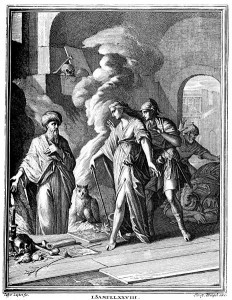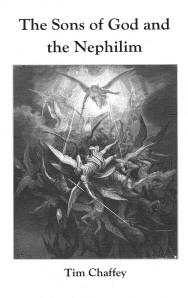
The Spirit of Samuel and King Saul at En Dor by Casper Luiken (1712).
One of the strangest accounts in Scripture appears in 1 Samuel 28. On the night before his death, Israel’s first king, Saul, made an infamous visit to a medium in hopes of contacting the deceased prophet Samuel. What happened during their encounter has been the source of some contention among interpreters.
King Saul fought many battles, and it was customary for him to seek the Lord’s favor prior to a conflict. This is not to say that he was a faithful king, but he had previously wanted to hear from God before going to war (1 Samuel 13:12 and 15:1). And now that Samuel had passed away, Saul was quite fearful about what the following day’s battle against the Philistines would bring.
The mediums and spiritists had already been kicked out of the land (1 Samuel 28:3), but Saul still wanted to hear what Samuel had to say. So Saul and some of his men went to En Dor to ask a medium to contact Samuel for him—an action strictly forbidden in Deuteronomy 18:10–12. What happened next has been debated for centuries.
A “spirit” (1 Samuel 28:13) appeared and told Saul that he would die the next day. But was it really Samuel who appeared or was it an evil spirit impersonating Samuel?
A Satanic Impostor?
Matthew Henry’s comments represent the beliefs of many Christians on this issue. He confidently stated that Satan came “in disguise, in the disguise of Samuel’s mantle” ((Matthew Henry, Matthew Henry’s Commentary on the Whole Bible: Complete and Unabridged in One Volume (Peabody: Hendrickson, 1994), 432.))
For Henry, this is an open-and-shut case. He wrote, “That it could not be the soul of Samuel himself they might easily apprehend when it ascended out of the earth, for the spirit of a man, much more of a good man, goes upward, Eccl. 3:21.” ((Ibid. Italics in original.)) And since Satan is said to be able to transform himself into an angel of light (2 Corinthians 11:14), Henry believed that it is quite obvious that Satan was given permission to appear to Saul.
John Gill wrote in no uncertain terms that “this was a diabolical spectre, or apparition, or the devil, that appeared in the form and shape of Samuel, and mimicked him.” ((John Gill, Commentary of the Whole Bible, 1 Samuel 28:14.)) Gill’s main argument against the apparition being Samuel himself is that the Lord’s prophet would not have been at the beck and call of a witch.
This opinion is also shared in the Pulpit Commentary, and it has been quite popular among Christians in general. But does it really handle the text properly?
An Appearance of Samuel
As with any debated passage, it is important to carefully consider what the text actually states. In this strange encounter, we are told by the writer in very plain language that it was Samuel who appeared to Saul. Consider each of the following verses, and notice that they are not spoken by Saul or the medium, but are part of the narration. In other words, it is the author of 1 Samuel 28 who is telling us that Samuel appeared.
“When the woman saw Samuel, she cried out with a loud voice.” (v. 12)
“And Saul perceived that it was Samuel, and he stooped with his face to the ground and bowed down.” (v. 14)
“Now Samuel said to Saul, ‘Why have you disturbed me by bringing me up?’” (v. 15)
“Then Samuel said: ‘So why do you ask me, seeing the Lord has departed from you and has become your enemy?’” (v. 16)
“Immediately Saul fell full length on the ground, and was dreadfully afraid because of the words of Samuel.” (v. 20)
Five times the narrator tells us that it was Samuel. The author gives no indication in the text that this is not really Samuel. It does not say, “Now the spirit impersonating Samuel said to Saul…” or anything of the sort. The text simply tells us that Samuel appeared and delivered a message to Saul.
Accurate Prophecy
Indeed, the straightforward meaning of the text is that it actually was Samuel who appeared to Saul. While this alone makes a strong case for the position, it is not the only evidence. What Saul was told by the “spirit” also came to pass.
Because you did not obey the voice of the Lord nor execute His fierce wrath upon Amalek, therefore the Lord has done this thing to you this day. Moreover the Lord will also deliver Israel with you into the hand of the Philistines. And tomorrow you and your sons will be with me. The Lord will also deliver the army of Israel into the hand of the Philistines. (1 Samuel 28:18–19)
On the following day, Saul and his sons were slain by the Philistines (1 Samuel 31:6), just as Samuel had foretold. The Israelite army was also defeated, as prophesied by the apparition (1 Samuel 31:1, 7).

My Th.M. thesis on the sons of God and the Nephilim addresses the meaning of ‘elohim at length. It is available in print or for Kindle.
If this were an evil impostor who appeared, then we would need to conclude that this entity told the truth and accurately foretold the future. Granted, it was the very near future, and many could have guessed the outcome of the battle. Even Saul feared for his life, which is why he sought out the medium in the first place (1 Samuel 28:5). Nevertheless, Jesus said that Satan is the father of lies who “does not stand in the truth, because there is no truth in him” (John 8:44). Why should we think that in this passage Satan shows up and speaks the truth?
Taking the text at face value makes far more sense, and this would mean that Samuel appeared to Saul. This type of action is almost certainly not a normal ability for a deceased human, so it seems as if God made an exception here and sent His prophet to deliver a message of judgment to the wayward king of Israel.
Conclusion to Part 1
I’m only halfway through the investigation of this passage. In the next post on this subject, I’ll cover some other passages that shed some light on the correct interpretation of this strange encounter. Also, this account provides an opportunity to clear up an important misunderstanding many Christians have about the Hebrew word ’elohim. Here’s a hint: that’s the word translated as “spirit” in this passage.
Thanks for reading!

“Here’s a hint: that’s the word used to describe
Thanks for reading!”
Lol, was that cliffhanger intentional?
This is a fascinating article on a fascinating subject. I’ve been hesitant about the impersonation view for similar reasons — the text doesn’t really do anything to indicate that. I mean, it could just be being described “in-character”, with no need to clarify what was actually happening — the emphasis could just be on Saul’s sin, not whether what he tried actually worked. But there’s really no indication of that.
Joel,
That’s pretty funny about the cliffhanger. I’m not sure what happened there. {shakes head} Thanks for pointing it out—it’s now fixed. But that did make a pretty good cliffhanger.
If you read part 2, which will probably go up within the next few days, then you’ll see there are several other verses that point to this actually being an appearance of Samuel. Thanks for the comment. I know I can count on you to help me edit. God bless!
As I suspected…fascinating…can’t wait for part 2!